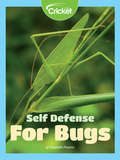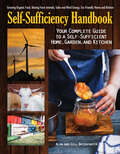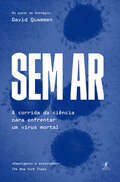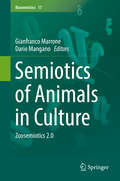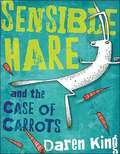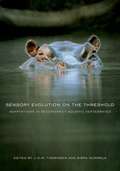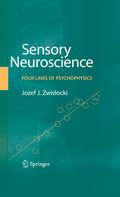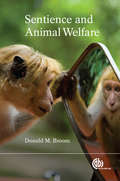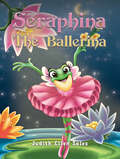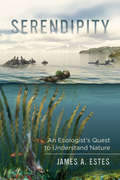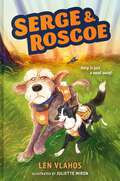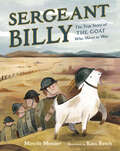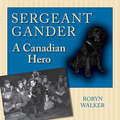- Table View
- List View
Self-Defense for Bugs
by Elizabeth PrestonHave you ever wondered how insects defend themselves from predators? Some, like the stick insect and katydid, use amazing disguises to help blend into their surroundings! Others, like wasps, hornets, and some caterpillars, use a painful venom to discourage attackers. If you were a bug, what sort of defense would you use?
Self-Recognition in Fish: Exploring the Mind in Animals
by Masanori Kohda Shumpei SogawaThis book describes the process of making the major breakthrough in the study of animal self-awareness using fish. The discovery led by the author&’s team, proving the mirror self-recognition ability of fish, is vividly documented as they share the process of making, testing and verifying hypotheses and developing further hypotheses. The clear experimental results demonstrate the remarkable self-awareness in animals, overturning the conventional view and providing a key to understanding the origin of human self-awareness. Starting from the current understanding of fish brains, individual recognition by its face, the following chapters introduce the series of the authors&’ research projects designed to understand mirror self-recognition (MSR) in animals. The sequence of the research into fish&’s MSR is documented, including how it started, the failures and successes, and the struggles. Additional tests carried out in response to various criticisms of the work have led to a re-examination of the research methods used prior to the author&’s work. The book then addresses the question of exactly when and how some fish recognize themselves in a mirror, exploring the self-awareness and the &“mind&”, in other word &“Eureka moment&” in fish. This book points out and overturns the contradictions in conventional wisdom based on anthropocentrism and hypotheses about the evolution of self-awareness, proposing a new hypothesis that the self-awareness of humans and fish will be homologous. The book takes readers on an engaging exploration of the scientific experiments and the remarkable discovery of animal intelligence.
Self-Sufficiency Handbook: Your Complete Guide to a Self-Sufficient Home, Garden, and Kitchen
by Gill Bridgewater Alan BridgewaterWhether you&’re looking to adopt a greener lifestyle or wanting to go off the grid, this guide has all you need to know to boost your self-sufficiency. Worried about ever-rising fuel bills and longing for the day when you can be off-grid and independent? Anxious about the quality of the food you eat and planning to go organic? Yearning to get back to the way it was but don&’t know where to start? This book will show you how to achieve the eco-friendly good life. The authors cover the ecological gamut from geothermal heating to crop rotation to soap making. They answer important questions like how much land is really needed to be self-sufficient, whether or not to depend entirely on natural forms of energy, and which farm animals will best meet your needs. There&’s practical information here on building an insulated flue pipe chimney, identifying edible wild plants, and composting with worms—as well as recipes for jams, rhubarb wine, cheeses, and more. Packed with full-color photographs, helpful illustrations, and diagrams, Self-Sufficiency Handbook will appeal to urban dwellers who want to adopt certain aspects of greener living and to serious adherents of back-to-basics living.Inside Self-Sufficiency Handbook, you&’ll find: –Inspirational yet practical introduction to a greener way of living –Essential reading for anyone considering a shift to a more self-sufficient lifestyle, no matter how small the change –Emphasis is on the positive aspects of self-sufficiency, such as cutting living costs and eating well –Covers everything from fitting a wind turbine to making honey from your own beehives. –Step-by-step instructions on keeping animals, growing organic food, and preserving your own produce –Guidelines for creating a self-sufficient home and eco-friendly home improvements&“This book shows that self-sufficiency is not only better for the planet—it&’s cheaper and more rewarding!&” —Green Rewards/Sustainability Advisory Panel
Selfie
by Sandy HorsleyClick! Click! Click! Sylvie the Squirrel is obsessed with selfies. However, as she's clicking away, Sylvie is missing out on the fun right in front of her. When her friends save her from a scary situation, Sylvie realizes what's really important and it's not taking selfies. Social media starts at an early age, and debut author/illustrator Sandy Horsley brings that issue to the forefront in this timely picture book. Selfies are fun, but nothing is more fun than being a good friend and living in the moment.
Selfish Pigs
by Andy RileyBack on the farm, the pigs are restless, and pissed. Smoking, pork-eating, overweight and without any s**t to roll in, these pigs aren't your cuddly, oinking kind of farmyard brother. They are mean and they are angry. From the genius behind the bestselling BUNNY SUICIDES series comes a hilarious new collection of illustrations that confirms all our worst fears: the pigs won't take it lying down.
Selkie Girl
by Laurie BrooksPoignant, meaningful, and romantic, "Selkie Girl" is a lyrical debut about a mesmerizing legend and a young girl who learns the truth about her mother and her own past.
Sem ar: A corrida da ciência para derrotar um vírus mortal
by David QuammenDavid Quammen, um dos mais conceituados jornalistas científicos, traz-nos toda a verdade sobre o SARS-CoV-2, uma narrativa cativante e essencial para perceber a origem da pandemia que moldou a atualidade. Em 2020, o hemisfério ocidental foi surpreendido por um novo coronavírus e uma crise pandémica com consequências globais. No entanto, para os cientistas que conheciam e estudavam os vírus zoonóticos, o aparecimento do SARS-CoV-2 não foi inesperado. Há muito que alertavam inequivocamente para a probabilidade muito elevada de uma pandemia.Com base em entrevistas a mais de 90 virologistas, epidemiologistas e outras autoridades, David Quammen, um dos mais reputados jornalistas científicos da atualidade, explora as consequências da ação humana na passagem do vírus dos animais para a nossa espécie e analisa com objetividade as hipóteses sobre a sua origem, rejeitando conspirações e teorias pouco fundamentadas. Explica ainda como é provável que os humanos tenham de adaptar-se para conviver em permanência com o SARS-CoV-2, a circular entre nós e a atormentar-nos com as suas intermináveis mutações. Sem ar reflete o espírito colaborativo da ciência, ao traçar um retrato fulgurante do esforço que uniu a comunidade científica em todo o mundo para decifrar a natureza do vírus que redefiniu a atualidade, parar a sua propagação e impedir que se repita. Os elogios da crítica: «Empolgante e assustador. Um relato apaixonado e esclarecedor sobre a crise definidora da atualidade.» The New York Times «Sem ar, tal como o vírus que retrata, é o culminar dramático da ideia […] de que a história da ecologia viral, na sua vertente científica, poderá facilmente tornar-se na maior história do planeta Terra.» The Atlantic «Três anos depois do início da pandemia, Quammen, prolífero autor e jornalista científico, desvela os mais variados detalhes sobre o esforço para investigar a propagação da covid-19 e identificar o que a tornou tão ameaçadora… Uma crónica de investigação científica, escrita de modo envolvente.»The Wall Street Journal «Sem ar apresenta uma abrangente história científica da pandemia, ligando as peças do puzzle que, à época, pareciam tão desconexas.» Science News «Uma nova história credível da covid-19 e dos seus antecessores… [Quammen] constrói um retrato exímio da evolução viral que culminou na covid-19. Informação perturbadora sobre saúde pública comunicada com brilhantismo por um perito.» Kirkus Reviews «Uma leitura essencial para quem queira perceber melhor a pandemia.» Publishers Weekly«Há poucos escritores que consigam compreender as cadeias de aminoácidos que dão a estes vírus os seus códigos particulares, muito menos os que conseguem relacioná-los com outros vírus SARS. E são ainda mais raros os que têm os dons literários necessários para tornar a genómica compreensível para um leigo. Felizmente, David Quammen […] é um deles.» The Guardian
Semi-aquatic Mammals: Ecology and Biology
by Glynnis A. HoodSemi-aquatic mammals are some of the rarest and most endangered mammals on earth. What binds them together in the minds of biologists, despite their diverse taxa and body forms, are evolutionary traits that allow them to succeed in two worlds—spending some time on land and some in the water. Semi-aquatic Mammals fills a crucial void in the literature by highlighting the important ecological roles and curious biology of these remarkable animals.In this unique book, wildlife ecologist Glynnis A. Hood presents the first comprehensive examination of a global suite of 140 freshwater semi-aquatic mammals. Each one has overcome the distinct ecological challenges of thriving in both aquatic and terrestrial habitats as part of everyday life. Covering millions of years, Hood's exploration begins with the extinct otter-like Buxolestes and extends to consider the geographical, physical, behavioral, and reproductive traits of its present-day counterparts. Hood explains how semi-aquatic mammals are able to navigate a viscous environment with almost no resistance to heat loss, reveals how they maintain the physical skills necessary to avoid predation and counter a more thermally changeable environment, and describes the array of adaptations that facilitate success in their multifaceted habitats. She also addresses specific conservation challenges faced by these mammals.Her analysis takes readers to the haunts of intriguing semi-aquatic mammals from around the world,• introducing the "paradoxical platypus," an Australian egg-laying monotreme that detects prey through electroreception• venturing into the swamps and mangroves of Southeast Asia, where fishing cats wave their paws above the water's surface to lure prey• trawling the streams and lakes of South America, where the female water opossum uses its backward-facing pouch to keep her babies warm during deep dives• spending time with species that engineer freshwater habitats into more productive and complex systems, including North American beavers and Africa's common hippopotamusFeaturing award-winning artist Meaghan Brierley's stunning illustrations throughout, Semi-aquatic Mammals is an unparalleled reference on some of the world's most tenacious and fascinating mammals.
Semiotics of Animals in Culture: Zoosemiotics 2. 0 (Biosemiotics Ser. #17)
by Gianfranco Marrone Dario ManganoTo place animals within the realm of nature, means inserting them among the articulations of culture and the social. Semiotics has never avoided this chiasmus, choosing to deal from the outset with the problem of the languages of animals following the old admonition of Montaigne: it is not that animals do not talk, it is us who do not understand them.Recent research in the field of the anthropology of nature and sociology of sciences and techniques allow to think about the Zoosemiotic issue in a different way. Instead of transplanting the language structures – gestures, LIS, etc. – for a semiotic study of the forms of the human and social meaning, it seems more apt to look at their discourse, and as such, the actual interactions, communicative and scientific as well as practical and functional, between humans and non-humans. This book aims to investigate precisely this hypothesis, known here as Zoosemiotics 2.0, working on several fronts and levels:· Anthropology· Languages of the image and visual representations, from art history to cinema· Old and new media. From literature to comics, from cartoons to TV documentaries but also advertising, music, Web and social networks. All those cultural products that talk about the role of human and non-human in society implicitly proposing (and in some way imposing) a form of articulation of such a relationship.· Food and feeding rites· Animalist, vegetarian and vegan movements · Philosophy: metaphysics, ethics, aesthetics
Senior Dogs
by Kim Campbell Thornton Buck JonesWhether teaching a dog the basics, turning Fido from frumpy to fabulous, or traveling with man's best friend, Dog Fancy magazine's Simple Solutions books are best bets for dog owners. Filled with helpful tips and fun illustrations, these handy guides serve as easy-to-use foundations for success.
Senolytics in Disease, Ageing and Longevity (Healthy Ageing and Longevity #11)
by Marco Demaria Daniel Muñoz-EspinThis book offers comprehensive information on the new and rapidly evolving science of identifying and targeting senescent cells, and on the exciting prospect of new diagnostic and therapeutic opportunities for stopping, and even reversing, the progression of disease and the deterioration of the human body due to ageing. According to recent United Nations data, by 2050 one in six people worldwide will be older than age 65, with peaks rising to one in four people in Europe and North America. Remarkably, the number of persons aged 80 years or older is expected to triple, from 143 million in 2019 to 426 million in 2050. First documented in the 1960s, the concept of cellular senescence as an underlying cause of ageing has been established in the course of the last decade. Using genetically engineered mouse models, researchers have demonstrated that the selective elimination of senescent cells can block and even reverse a number of age-related dysfunctions and pathologies, promoting both better health and longer life in the elderly. These include cardiovascular diseases; neurological disorders; type 1 and type 2 diabetes; inflammatory diseases; fibrosis; geriatric syndromes; chronic diseases resulting in organ dysfunction; the integrity of the musculoskeletal system; and cancer. Some senolytic agents have already progressed into trials. These include UBX0101 for the treatment of osteoarthritis (now in phase II), a cocktail of dasatinib and quercetin for the management of idiopathic pulmonary fibrosis and chronic kidney disease, and ABT-263 in combination with senescence-inducing chemotherapies for the treatment of advanced solid tumours. In addition, the book discusses pathways to early phase clinical trials and translational approaches in medicine and ageing, highlighting new opportunities as well as current limitations, challenges and alternatives. Given its scope, it will benefit a broad audience of advanced educators, researchers, graduate students and practitioners.
Sensible Hare and the Case of Carrots: A Carrot Noir
by David Roberts Daren KingSensible Hare was not a sensible hare. But he was a hare, and he had the ears to prove it. Sensible Hare, Hare Detective has a relaxing job - until a sassy ladyhare comes into his office asking for help to track down a missing suitcase of carrots. It is going to be a tough carrot to munch, but Sensible hasn't had a case in months - he's behind with the rent , and the landlord is on his tail - so he accepts the case. And soon, he is being trailed by every villain in town. So begins an outrageous adventure of Hare Shampoo, dangerous scrapes, carrots and foxy ladyhares . . .
Sensory Evolution on the Threshold: Adaptations in Secondarily Aquatic Vertebrates
by J. G. M. Thewissen Sirpa NummelaThis synthesis explores the function and evolution of sensory systems in animals whose ancestors lived on land. Together, the contributors explore the dramatic transformation of smell, taste, sight, hearing, balance, mechanoreception, magnetoreception, and electroreception that occurred as lineages of amphibians, reptiles, birds, and mammals returned to aquatic environments.
Sensory Neuroscience: Four Laws of Psychophysics
by Jozef J. ZwislockiSensory Neuroscience: Four Laws of Psychophysics organizes part of psychophysics -- a science of quantitative relationships between human sensations and the stimuli that evoke them. Although psychophysics belongs to sensory neuroscience, and is coupled to neurophysiology, it has also branched out to various specialized disciplines, including the disciplines of vision and hearing, ophthalmology, optometry, otology, and audiology. Due to this diversification and fragmentation, psychophysics has had an ad-hoc, phenomenological orientation. Besides Weber's law of differential sensitivity, and the still-controversial Stevens' power law, it has lacked a systematic grid of scientific laws. Sensory Neuroscience: Four Laws of Psychophysics provides valid unifying principles and systematic applications for this otherwise fragmented precursor of experimental psychology, and defines four multisensory relationships of substantial generality between sensations and the underlying stimulus variables. This book will be particularly useful to auditory researchers, experimental psychologists, and behavioral neuroscientists.
Sensory Systems of Animals: Biology and Behavior
by Mark HollinsPerception in animals is a fascinating and challenging subject that calls to students from many disciplines. The aim of this book is to provide a knowledge base and unifying perspective on the field that will enable beginning researchers to chart their own course within it. The author describes, in a systematic but engaging way, the sensory systems of humans and other vertebrates, as well as arthropods and molluscs.Why is it important to understand the senses of animals? One reason is that human activities are changing the perceptual world of animals in ways that expose them to danger. From bright outdoor lighting disorienting migrating birds to human sonar driving whales to beach themselves; it is becoming increasingly important to find ways to reduce such dangers. This will require big changes in human behavior, and greater understanding of how animals react, physiologically and behaviorally, to anthropogenic changes in their environment.The emphasis throughout is on research, in both the behavioral/ethological and neuroscientific traditions, that has led to important discoveries. The functional anatomy of each system, from receptor cells to brain areas, is succinctly described, explaining how it underlies the animal’s sensory abilities and behavior. Overall descriptions of a sense for a class of animals (for example, hearing in arachnids) are interspersed with expanded coverage of that sense in a particular animal, such as the ogre-faced web-casting spider that does a backflip to capture an insect buzzing overhead. Evolutionary themes are found throughout the book, for example in describing the development of the vertebrate ear, and in the convergent evolution of the eyes of vertebrates and cephalopods.With over 500 references and 80 illustrations, this textbook is intended as primary reading for advanced undergraduates and beginning graduate students of biology, neuroscience, sensory psychology, and veterinary science. It will also be of interest to professionals and academics in these fields, and to anyone else who works with or studies animals.
Sentience and Animal Welfare
by Donald BroomSentience - the ability to feel, perceive and experience - is central to the animal welfare debate as it raises the question of whether animals experience suffering in life and death. This book explores and answers these questions in an objective way, based on the latest research and empirical evidence. Beginning with an introduction to sentience, the book investigates why we are so interested in sentience, when, as a species, humans became sentient and how it has changed over time. The book defines aspects of sentience such as consciousness, memory and emotions, and discusses brain complexity in detail. Looking at sentience from a developmental perspective, it analyses when in an individual's growth sentience can be said to appear and uses evidence from a range of studies investigating embryos, foetuses and young animals to form an enlightening overview of the subject. With a full chapter covering ethical decisions such as animal protection and experimentation, this book is not only an invaluable resource for researchers and students of animal welfare and biology, but also an engaging and informative read for veterinarians and the general public.
Sentience and Animal Welfare
by Donald BroomSentience – the ability to feel, perceive and experience – is central to the animal welfare debate as it raises the question of whether animals experience suffering in life and death. This book explores and answers these questions in an objective way, based on the latest research and empirical evidence. Beginning with an introduction to sentience, the book investigates why we are so interested in sentience, when, as a species, humans became sentient and how it has changed over time. The book defines aspects of sentience such as consciousness, memory and emotions, and discusses brain complexity in detail. Looking at sentience from a developmental perspective, it analyses when in an individual’s growth sentience can be said to appear and uses evidence from a range of studies investigating embryos, foetuses and young animals to form an enlightening overview of the subject. With a full chapter covering ethical decisions such as animal protection and experimentation, this book is not only an invaluable resource for researchers and students of animal welfare and biology, but also an engaging and informative read for veterinarians and the general public.
Sentient: How Animals Illuminate the Wonder of Our Human Senses
by Jackie HigginsPerfect for fans of The Soul of an Octopus and The Genius of Birds, this &“revelatory book&” (Sy Montgomery, New York Times bestselling author) explores how we process the world around us through the lens of the incredible sensory capabilities of thirteen animals, revealing that we are not limited to merely five senses.There is a scientific revolution stirring in the field of human perception. Research has shown that the extraordinary sensory powers of our animal friends can help us better understand the same powers that lie dormant within us. From the harlequin mantis shrimp with its ability to see a vast range of colors, to the bloodhound and its hundreds of millions of scent receptors; from the orb-weaving spider whose eyes recognize not only space but time, to the cheetah whose ears are responsible for its perfect agility, these astonishing animals hold the key to better understanding how we make sense of the world around us. &“An appealingly written, enlightening, and sometimes eerie journey into the extraordinary possibilities for the human senses&” (Kirkus Reviews, starred), Sentient will change the way you look at humanity.
Seraphina The Ballerina
by Judith Ellen SalesSeraphina is no ordinary frog: she dreams of being a prima ballerina, dazzling audiences on the big stage. Her wish comes true in the most unexpected way when a twist of fate lands her in the spotlight. Though small and green, Seraphina has grace and talent beyond her pond. She finds herself leaping, spinning, and twirling for a crowd under the bright lights. It’s everything she imagined and more – though the path to living her dream takes surprising turns.
Serendipity and Me
by Judith RothSara has always loved cats. She surrounds herself with pictures of cats, stuffed cats, even cat-headed slippers. But she's never been allowed to have a real cat of her own. Her father has always told her no, for reasons he won't explain. <P><P> So when a fluffy snowball of a kitten darts through their front door and into her life, Sara believes her dream might finally come true. But convincing her father to break his strict No Cats policy seems impossible. She has less than a week to persuade him that this kitten is exactly what their lonely, broken family of two needs to heal. <P> Told in lyrical, spare verse, Serendipity & Me is a sparkling novel that elegantly handles the topic of loss for a middle grade audience.
Serendipity: An Ecologist's Quest to Understand Nature (Organisms and Environments #14)
by James A. EstesTo newly minted biologist James Estes, the sea otters he was studying in the leafy kelp forests off the coast of Alaska appeared to have an unbalanced relationship with their greater environment. Gorging themselves on the sea urchins that grazed among the kelp, these small charismatic mammals seemed to give little back in return. But as Estes dug deeper, he unearthed a far more complex relationship between the otter and its underwater environment, discovering that otters play a critical role in driving positive ecosystem dynamics. While teasing out the connective threads, he began to question our assumptions about ecological relationships. These questions would ultimately inspire a lifelong quest to better understand the surprising complexity of our natural world and the unexpected ways we discover it. Serendipity tells the story of James Estes's life as a naturalist and the concepts that have driven his interest in researching the ecological role of top-level predators. Using the relationships between sea otters, kelp, and sea urchins as a touchstone, Estes retraces his investigations of numerous other species, ecosystems, and ecological processes in an attempt to discover why ecologists can learn so many details about the systems in which they work and yet understand so little about the broader processes that influence these systems. Part memoir, part natural history, and deeply inquisitive, Serendipity will entertain and inform readers as it raises thoughtful questions about our relationship with the natural world.
Serge & Roscoe
by Len VlahosTwo mismatched rescue dogs, Serge, an otterhound on the verge of retirement, and Roscoe, a border collie fresh out of the academy, are forced to team up to save the day when a wildfire ravages a Colorado forest. Roscoe is a Search and Rescue Force rookie who doesn’t play by the rules. Serge is a veteran of the Force, looking forward to a well-earned retirement. Roscoe can’t wait to make his first rescue, while Serge just wants to get through the next three days so he can finally just . . . chillax.But when the largest fire Colorado has ever seen starts tearing through the forest, it’s all paws on deck for the Search and Rescue team. Serge and Roscoe are thrown together as partners, and with lives on the line, there’s no time for them to not get along. Will this mismatched team figure out how to work together to save the day? Get your woof on in this story of bravery, adventure, and doggy snacks from beloved author and longtime bookstore owner Len Vlahos.Perfect for fans of Max: Dog, Hero, Marine and Zootopia.
Sergeant Billy: The True Story of the Goat Who Went to War
by Mireille MessierA delightful tale inspired by the true story of a brave goat war hero. Perfect for fans of Finding Winnie and Rescue and Jessica. During World War I, a goat named Billy was adopted by a platoon of soldiers and made his way across the ocean to be part of the war effort.Billy . . .Trained with the soldiersWas smuggled across the oceanGot snuck into the frontlines in a box of orangesAte some secret documents and was arrested for treasonGot trench footHead-butted soldiers into a trench and saved them from a shellCame back home a decorated war heroThis charming true story follows Sergeant Billy from his small prairie town to the trenches of World War I and back, through harrowing moments, sad moments, moments of camaraderie and moments of celebration. This unforgettable goat and the platoon that loved him will capture your heart!
Sergeant Gander: A Canadian Hero
by Robyn WalkerSergeant Gander is a fascinating account of the Royal Rifles of Canadas canine mascot, and his devotion to duty demonstrated during the Battle of Hong Kong in the Second World War. Armed only with his formidable size, an intimidating set of teeth, and a protective instinct, Gander rought alongside his fellow Canadian soldiers. As the Royal Rifles’ position become more precarious, the men were forced to retreat into the hills of Hong Kong, and it was here that a group of wounded Canadians, threatened by a live grenade, came to fully appreciate the loyalty of Gander. For his service in battle, Sergeant Gander was awarded the Dickin Medal, the animal equivalent to the Victoria Cross for humans. This honour is dedicated to animals displaying gallantry and devotion to duty while under any control of the armed forces. Sergeant Gander is the nineteenth dog to receive this medal and the first Canadian canine to do so.
Sergeant Reckless (Animals to the Rescue #2)
by Emma Carlson BerneThe legendary tale of Sergeant Reckless comes to life in this heavily illustrated nonfiction chapter book series perfect for fans of Ranger in Time!Born to be racehorse in Seoul, Korea, Reckless was always destined for greatness. Then the Korean War began in 1950, and those dreams were dashed. But when Reckless was bought by a group of US Marines to work on the frontlines, it quickly became clear that this little mare had the heart of a hero.This action-packed series explores the stories of real-life animal heroes who saved the day! With black-and-white art throughout and dramatic storytelling, readers are taken on an exciting journey they won't soon forget.Fans of Ranger in Time will devour these true tales of incredible animal heroes!
